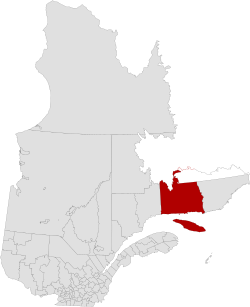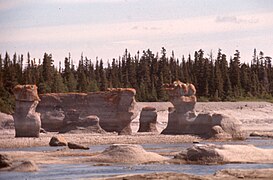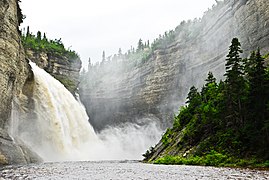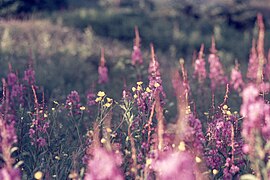| Minganie | |
|---|---|
| Regional county municipality | |
 | |
| Coordinates: 50°14′N 63°36′W / 50.233°N 63.600°W / 50.233; -63.600 | |
| Country | Canada |
| Province | Quebec |
| Region | Côte-Nord |
| Effective | January 1, 1982 |
| County seat | Havre-Saint-Pierre |
| Government | |
| • Type | Prefecture |
| • Prefect | Meggie Richard |
| Area | |
| • Total | 63,731.31 km (24,606.80 sq mi) |
| • Land | 53,340.31 km (20,594.81 sq mi) |
| Includes native reserves | |
| Population | |
| • Total | 6,467 |
| • Density | 0.1/km (0.3/sq mi) |
| • Pop (2016-21) | |
| • Dwellings | 3,306 |
| Includes native reserves | |
| Time zone | UTC−5 (EST) |
| • Summer (DST) | UTC−4 (EDT) |
| Area code(s) | 418 and 581 |
| Website | mrc |
Minganie (French pronunciation: [mɛ̃ɡani]) is a regional county municipality on the north shore of the Gulf of St. Lawrence, in Côte-Nord region, Quebec, Canada, its territory includes Anticosti Island.
Toponymy

Both the largest (128,473 km²) and the penultimate of the least populated, the regional county municipality of Minganie extends from Labrador to the middle of the Honguedo Strait in the St. Lawrence River and includes the hinterland of Le Golfe-du-Saint-Laurent RCM and Anticosti Island.
Construction workers, transport workers, miners, fishermen and trappers are also found there in larger proportions than in Quebec in general.
The origins of Minganie's population can be traced to Innu, Acadian and Gaspesians pioneers and its new residents who arrived via Route 138 (The Whale Route - Route Jacques-Cartier), opened in 1976.
Administration
The RCM administration is seat is Havre-Saint-Pierre. It has an area of 63,731.31 square kilometres (24,606.80 sq mi) according to Quebec's Ministère des Affaires municipales, des Régions et de l'Occupation du territoire (which includes coastal, lake, and river water territory), or a land area of 53,340.31 square kilometres (20,594.81 sq mi) according to Statistics Canada. Its population in the 2021 Canadian census was 6,467. The majority live in Havre-Saint-Pierre.
Minganie and the neighbouring Le Golfe-du-Saint-Laurent Regional County Municipality are grouped into the single census division of Minganie—Le Golfe-du-Saint-Laurent (known as Minganie–Basse-Côte-Nord before 2010). The combined population at the 2021 Canadian census was 9,849.
Until 2002, Minganie RCM encompassed the entire lower north shore right up to Blanc-Sablon. In 2002, it lost all the coastal communities east of the Natashquan River when the Basse-Côte-Nord Territory was formed. In July 2010, the RCM lost another 44% of its territory when the (uninhabited) Petit-Mécatina unorganized territory was transferred to the newly created Le Golfe-du-Saint-Laurent Regional County Municipality, which superseded Basse-Côte-Nord.
Overview of the region
Several portions of territory on the Minganie are dedicated specifically to the protection and maintenance of heritages.
- Heritages sites in the region
-
 Johan Beetz House (Le Chateau)
Johan Beetz House (Le Chateau)
-
 Wastishou Migratory Bird Sanctuary
Wastishou Migratory Bird Sanctuary
-
 Mingan Archipelago National Park Reserve, geological site
Mingan Archipelago National Park Reserve, geological site
-
 Sault Plat River, geological site
Sault Plat River, geological site
-
 Anticosti Island UNESCO's World Heritage
Anticosti Island UNESCO's World Heritage
Subdivisions
There are 9 subdivisions and 2 native reserves within the RCM:
|
|
|
Demographics
| Year | Pop. | ±% |
|---|---|---|
| 2011 | 6,613 | — |
| 2016 | 6,587 | −0.4% |
| 2021 | 6,467 | −1.8% |
| Population amounts include native reserves. Source: Statistics Canada | ||
Transportation
Sea - Air - Ground
Until the arrival of The Whale Route (Route 138) in 1976 and 1996, the only regular means of access to the area was the boat service maintained during the navigation season by Clarke Steamship Company, Ltd. The regularity of the service becomes more and more uncertain from the month of September, depending on the date of the arrival of winter with its snow, ice, storms and fog. However, it is possible to reach the area by chartering seaplanes that can easily land under favourable atmospheric conditions in many deep bays and on windward waters sheltered by islands.
Route & trails
Highways and numbered routes that run through the RCM, including external routes that start or finish on its borders.
|
|
|
|
In 2024, the Côte-Nord region is part of the network of the 33 000 km of trails of The Federation of Snowmobile Clubs of Quebec and La Minganie Snowmobile Club, based in Les Escoumins, offer detailed interactive maps on the different circuits and their points of services.
River basins


There are a number of large rivers that flow in a generally north–south direction through Minganie to enter the Gulf. Near the coast the river basins tend to narrow in towards the river mouth, and between their mouths are areas that drain into the Gulf through smaller streams. From west to east, the larger river basins, which may cover parts of Labrador, Sept-Rivières or Le Golfe-du-Saint-Laurent, are:
Flora

With the exception of a few enclaves, the ecological region of Minganie is mainly covered by large Spruce forests and a few laricinin fields (Larix laricina (Du Roi) K. Koch). There are also White spruce (Picea glauca (Moench) Voss.), Dwarf birch (Betula glandulosa Minchx), Rough alder (Alnus rugosa (DuRoi Spreng.) and Trembling aspen (Populus tremuloides Michaux).
Brothers Marie-Victorin and Rolland Germain F.E.C. explored the region from 1924 to 1928. Their work has raised awareness in the scientific community of the enormous value of the Mingan Archipelago. Since then, other scientists have added to the ecology and phytogeography knowledge of this sector.
The vegetation of the Mingan Islands belongs to the Chibougamau-Natashquan boreal forest region, which is dominated by Black spruce. The high latitude and low altitude, combined with the proximity of the cold currents of Labrador, explain the subarctic vegetation specific to the Minganie.
The entirely calcareous nature of the horizontal stratified rocks, which make up the Anticosti - Minganie, exerts a profound influence on the structure of the flora and on the choice of species.
Remarkable for its richness, the flora includes 350 vascular plants including the presence of two rare taxa: Cirsium foliosum var. Minganense and Cypripedium passerinum var. Minganense. Sixty species are new to the list of Minganie harvests compiled by Marie-Victorin and Rolland-Germain (1969). There were also 150 bryophytes and 152 lichens, 29 of which were additions to the Nouveau Catalogue des lichens, published by Lepage (1972).
Overwiew of the diversity
- Vegetation of Quebec's Cold Sea Shores
-
 Epilobium angustifolium Linné. — Épilobe à feuilles étroites. — Bouquets rouges. — (Fireweed).
Epilobium angustifolium Linné. — Épilobe à feuilles étroites. — Bouquets rouges. — (Fireweed).
-
 Spiranthes romanzoffiana Chamisso. – Spiranthe de Romanzoff. – (Romanzoff's ladies'-tresses).
Spiranthes romanzoffiana Chamisso. – Spiranthe de Romanzoff. – (Romanzoff's ladies'-tresses).
-
 Campanula rotundifolia Linné. – Campanule à feuilles rondes. – (Bluebell).
Campanula rotundifolia Linné. – Campanule à feuilles rondes. – (Bluebell).
-
 Ledum groenlandicum. — Lédon du Groenland. — Thé du Labrador, Thé velouté. — (Labrador Tea).
Ledum groenlandicum. — Lédon du Groenland. — Thé du Labrador, Thé velouté. — (Labrador Tea).
-
 Rubus chamaemorus Linné. — Ronce petit-mûrier. — Mûres blanches, Blackbières, Plaquebières, Chicoutés. — (Cloudberry).
Rubus chamaemorus Linné. — Ronce petit-mûrier. — Mûres blanches, Blackbières, Plaquebières, Chicoutés. — (Cloudberry).
Fauna

Terrestrial mammals
During the summers of 1964 and 1965, during geological research, Jean Depatie with a team of geologists and students, assisted by 3 canoemen and lumberjacks, plus a cook, explored 440 square miles of a territory stretching from Sept-Îles to Blanc Sablon, in the Lac à l'Ours region. In the field, scientists noted an abundance of Canadian beavers, a few otters and American mink, many hares, partridges and a multitude of ducks. Caribou and moose are scarce while black bears and red foxes abound.
- Castor canadensis. -Castor du Canada -North American Beaver.
- Lontra canadensis. – Loutre du Canada. -North American river otter
- Ondatra zibethicus L. – Rat musqué. -Muskrat
- Vulpes vulpes L. -Renard roux. -Red fox
- Tamiasciurus hudsonicus. -Écureil roux - American red squirrel
- Lepus americanus. – Snowhoe hare. Lièvre d’Amérique
- Mustela erminea L. – Stoat. -Hermine
- Ursus americanus. - Ours noir. - (Black Bear)
- Alces alces. Orignal, Élan. -(Moose)
- Certain species of bats and a number of small rodents
Marine mammals

The waters of the St. Lawrence Estuary are internationally recognized as a vital feeding ground for rare or common species of marine mammals.
- Blue whale, Right whale, St. Lawrence beluga, Harbour porpoise, Fin whale, Harbour seal, Humpback whale, Minke whale, Atlantic white-side dolphin, Sperm whale, Grey seal, Harp seal
Birds
Many species of birds can be observed in the Côte-Nord region and the Mingan RCM, including Havre-Saint-Pierre and in Mingan Archipelago National Park Reserve
- Warblers, Terns, Ospreys, Passerines, Razorbills, many waders
- Haliaeetus leucocephalus. -Bald Eagle. -Pygargue à tête blanche
- Somateria mollissima. -Common Eider. -Eider à duvet
- Fratercula arctica. Macareux moine. -Atlantic Puffin
- Bucephala islandica. -Barrow's Goldeneye. -Garrot d'Islande
See also
References
- ^ "Répertoire des municipalités: Geographic code 981". www.mamh.gouv.qc.ca (in French). Ministère des Affaires municipales et de l'Habitation.
- ^ Derived indirectly from Ministère des Affaires municipales et de l'Habitation (MAMH) website, by summing up data for Aguanish (680.61 km), Baie-Johan-Beetz (532.06 km), Havre-Saint-Pierre (3932.33 km), L'Île-d'Anticosti (9291.18 km), Lac-Jérôme (46531.86 km), Longue-Pointe-de-Mingan (643.21 km), Mingan (38.38 km), Nutashkuan (1.19 km), Natashquan (695.43 km), Rivière-Saint-Jean (743.35 km), and Rivière-au-Tonnerre (641.71 km) total areas (total area given at website is 17,159.88 km which excludes the unorg. territory and reserves).
- ^ "Table 98-10-0018-01 Population and dwelling counts: Regional county municipalities (RCM), Quebec". www150.statcan.gc.ca. Government of Canada - Statistics Canada. 9 February 2022. Retrieved 5 June 2024.
- "Minganie, toponymy". Quebec Gouvernement (in French). Quebec Toponymy Commission. 7 March 1985. Retrieved 24 June 2024.
The Mingan archipelago and the adjoining coastline, famous for their limestone erosion patterns, and Anticosti Island, which forms a small world in itself, remain the great natural features of the Mingan region.
- "Visit Minganie" (in French). Regional County Municipality of Minganie. 3 June 2024. Retrieved 23 June 2024.
Between the boreal forest and the Gulf of the St. Lawrence River, only the immensity of the sky equals the grandeur of this vast region.
- "Minganie--Le Golfe-du-Saint-Laurent, Census division (CDR) Quebec. 2021 Census of Population". www12.statcan.gc.ca. Government of Canada - Statistics Canada. 9 February 2022. Retrieved 5 June 2024.
- Audrée Soucy (July 2010), "Municipalité régionale de comté (MRC)" (PDF), Modifications aux municipalités du Québec, Quebec: Institut de la statistique du Québec, ISSN 1715-6408, archived from the original (PDF) on 2011-06-12, retrieved 2010-09-17
- Ministry of Culture and Communications of Quebec (2006). "Johan Beetz House, heritage real estate". Heritage directory cultural of Quebec. Retrieved 18 June 2024.
Other name, Château Johan-Beetz
- "Network of observation sites along the Whale Route (Route 138)" (PDF). 2010-05-21. p. 12. Retrieved 11 May 2024.
Whale-watching sites for everyone
- "Whales of the St. Lawrence river". Whales Online. 2024. Retrieved 18 April 2024.
The estuary is home to belugas all year round. In summer, the estuary also hosts rorquals and other species of toothed whales that benefit from the abundance of krill, capelin and other small fish.
- "The Clarke Steamship Co Ltd" (PDF). 7 June 2014. pp. 41 of 74. Retrieved 17 May 2024.
The North Shore service now sailed from Quebec every Tuesday at 9 am, serving no fewer than thirty locales, consisting of pulpwood ports, native villages, trading posts and fishing settlements,
- Jacques Claveau (1950). "The North Shore of the St. Lawrence, from Aguanish to Washicoutai Bay, Saguenay County" (PDF) (in French). Ministère de l'Énergie et des Ressources naturelles - Gouvernement du Québec. pp. 8 of 78. Retrieved 18 May 2024.
Aguanish is about 515 miles downstream from the city of Quebec and about 90 miles due east of the village of Mingan.
- Official Transport Quebec Road Map
- "La Minganie Snowmobile Club". Côte-Nord entre nature et démesure. 2024. Retrieved 15 May 2024.
In order to preserve our magnificent North Shore in its wild state, we invite you to adopt the principles of the Leave No Trace code of ethics.
- Portrait préliminaire de la zone de gestion intégrée de l'eau par bassin versant Duplessis (PDF) (in French), OBV Duplessis, April 2015, p. 20, retrieved 2019-09-29
- Ministry of Natural Resources and Wildlife, Forêt Québec, Forest Inventory Branch (July 2007). "Guide to the Recognition of Ecological Types: Ecological Region Anticosti Island, Mingan Islands" (PDF) (in French). Quebec Gouvernement. Retrieved 19 January 2024.
an ecological region is a homogeneous unit in relation to the dynamics of vegetation and variables in the physical environment
{{cite web}}: CS1 maint: multiple names: authors list (link) - Marie-Victorin (1885–1944) (2003). "Avant-pays Anticosti-Minganie". florelaurentienne.com (in French). pp. 56 of 920. Retrieved 19 January 2024.
Because of the importance and biological autonomy of this archipelago, we have given it the name of Minganie
{{cite web}}: CS1 maint: numeric names: authors list (link) - "Flora of a thousand faces". Mingan Archipelago National Park Reserve. Gouvernement of Canada. 29 May 2014. Retrieved 19 January 2024.
The woodlands of the Mingan Islands are made up of Balsam Fir ( Abies balsamea ), Black Spruce ( Picea mariana ) and White Spruce ( Picea glauca ).
- Line Couillard and Pierre Grondin (3 January 2023). "The rare plants of Mingan archipelago" (PDF). Environnement Canada Parks. Retrieved 19 January 2024.
picking of all plants is strictly prohibited in national parks.
- Jean Depatie (1967). "Preliminaty Report on L'Ours lake area" (PDF). Ministère de l'Énergie et des Ressources naturelles - Gouvernement du Québec. p. 21. Retrieved 29 January 2024.
This study focuses on several coastal islands, which are part of the Mingan Archipelago, and covers 400 square miles of Duplessis County
- George Kolenosky (1992). "Black bear" (PDF). Minister of Environment, Minister of Supply and Services Canada. Retrieved 30 January 2024.
Favourite fruits include blueberries, buffalo berries, strawberries, elderberries, saskatoons, black cherries, and apples.
- Parks Canada (2022-11-19). "Mingan Archipelago National Park Reserve". Government of Canada. Retrieved 2024-01-16.
Seabirds, Seals, Whales, Land Mammals, occasionally, Black Bears and Moose
- "Mingan Island Cetacean Study (MICS)". 2024. Retrieved 31 January 2024.
The principal study areas include the Quebec North Shore in the Mingan Island / Anticosti region, the Gaspe Peninsula and St. Lawrence Estuary.
- "St. Lawrence Estuary Marine Protected Area (MPA) Project" (PDF). Fisheries and Oceans Canada. March 2010. pp. 13 of 76. Retrieved 31 January 2024.
Nearly half a dozen marine mammal species found in the estuary regularly or occasionally are species at risk listed
- "Centre d'interprétation de la Station de Recherche des Îles Mingan". Bonjour Quebec. 2024. Retrieved 31 January 2024.
Take a guided tour of the museum with field biologists and learn more about the marine mammals that inhabit the St. Lawrence River
- Park Canada (2019-10-24). "Betchouane Migratory Bird Sanctuary". Government of Canada. Retrieved 30 January 2024.
this sanctuary including large numbers of razorbill, Atlantic puffin, herring gull and great black-backed gull. Black-legged kittiwake and black guillemot
- "Bird Watching in Côte-Nord". Quebec by the sea. Retrieved 30 January 2024.
Côte-Nord is home to hundreds of bird species.
- Government of Canada (2020-12-24). "Marine Birds". Parks Canada. Retrieved 2024-01-18.
In order to ensure the reproductive success of these birds, certain islands or sectors of the islands are closed to public during the nesting period
External links
- Frère Marie-Victorin (1885-1944), Anticosti, land with immense spaces, the sea all around, and a social world of the 1920s gone forever. Anticosti/UdeM archives, 14 photos (French)
- Regional County Municipality of Minganie, official website, (French)
- Reception and interpretation center Parks Canada, Havre-Saint-Pierre, Longue-Pointe-de-Mingan, Aguanish, Baie-Johan-Beetz
- Portrait Minganie RCM, zoom on the population, RAP Côte-Nord, member of the Quebec Network for Educational Success (RQRÉ), April 2019, 4p.
| Adjacent Counties & Equivalent Territories | ||||||||||||||||
|---|---|---|---|---|---|---|---|---|---|---|---|---|---|---|---|---|
| ||||||||||||||||
| Administrative units |
| ||||
|---|---|---|---|---|---|
| Protected areas | |||||
| Major river basins | |||||
| Significant lakes | |||||
| Transport infrastructure | |||||
| |||||
| Regional county municipalities and equivalent territories | |
|---|---|
| Municipalities | |
| Administrative divisions of Quebec | |